Grad Dads: Mark Shand & Weslin Pullen

This week we present "Grad Dads," a very special edition of Another Wavelength featuring two recent Wyant College M.S. graduates of Spring 2022. These grads not only mastered their degrees but also mastered the balance of pursuing an advanced degree while supporting families.
Mark Shand is a father of three and completed his M.S. degree this spring under the mentorship of Professor Jim Schwiegerling. His research in lidar safety and the assumption of pupil size is closely tied to his work with Waymo autonomous vehicles. Moving forward, Mark will continue working at Waymo leading a team of software engineers on lidar systems for the vehicles you can already see driving themselves around Phoenix. Mark's thesis, "Optical Radiation Safety and Some Current Standards Initiatives" may be found on his alumni profile here.
Weslin Pullen is a father of four who recently completed his M.S. degree under the mentorship of Professor Dae Wook Kim. His thesis, "Statistical Tool Size Study for Computer Controlled Optical Surfacing" may be found on his alumni profile here. Next, Weslin will continue working at Raytheon as a Sr. Systems Engineer.
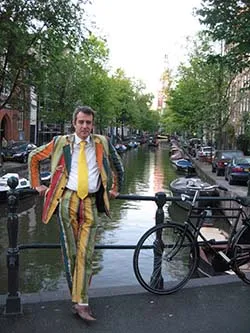
Mark Shand
Where are you from?
Sydney, Australia, but as an adult I lived and worked for many years in France, in and around Paris. For the past ten years, I have lived in Palo Alto, CA, but I hope to get back to our house in Dampierre-en-Yvelines eventually.
Why did you choose to advance your education by earning an M.S. in optics?
I have a Ph.D. in computer science but I have worked closely with optics numerous times in my career, for example building an early AO system for the Swedish Vacuum Solar Telescope in La Palma (10.1117/12.221333), designing hardware for video processing and overdrive in LCDs for display applications (US20110310974), and characterizing the color gamut of Google Glass. In 2015 I joined the Google Self-driving car project (now Waymo) to work on lidar systems. One aspect of this is scanning interlocks (US10797460B2). I got more and more deeply involved in the laser safety aspects and was invited to join IEC TC76, the committee that maintains the IEC optical safety standards like 60825, but I was worried I'd be revealed as a fraud. After all, I'd never even done OPTI506! Meanwhile, one lunchtime, Waymo’s lead optical engineer, Hamilton Shepard, a UA Ph.D. from 2009, recommended the OSC distance program to a junior colleague sitting next to me. I figured I could study optics too. Also, my eldest child was approaching college age so I had an example to set. As it turned out, I enrolled but the junior colleague never did.
Describe how your wife and children (and how being a dad) had a role in helping you to thrive throughout graduate school?
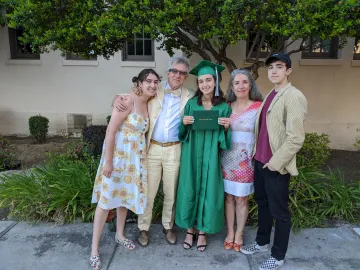
I kept my full time job through graduate school. I pursued my optics degree part time to keep the coursework manageable. We are a pretty studious family. My wife is a keen student of art and languages, I tend to cleave to the sciences. My youngest child was already in the last year of middle school when I started. So my studies were a great leveler: we all had homework to do on the weekend. I think it also put me in a better mindset to help my children with their homework. This past May was a great month for graduations in the Shand family. My oldest daughter graduated from college at the start of the month, I graduated with my master's mid-month, and my youngest daughter graduated high school at the end of the month. The family photo was taken at my youngest daughter's graduation.
Describe your research in 200 words or fewer.
Current laser safety standards for wavelengths that pose a retinal hazard assume a dark adapted 7mm pupil. In bright conditions is this overly conservative? When operating a lidar system outdoors in daylight could we be justified in assuming a smaller pupil? How would a smaller pupil affect the hazard? To answer the question of pupil size I reviewed and reconciled existing literature. For the question of affect on hazard, I leveraged clinical datasets from existing eye aberration studies gathered over several hundred individual eyes and developed a computer code to estimate peak retinal irradiance of a plane wave under varying pupil size. If the eye were a perfect lens the peak retinal irradiance would be the fourth power of the pupil diameter, a square factor from the collection area, and a square factor from the diffraction limit. But a typical eye is far from a perfect lens. In my work I was able to quantify the impact of aberration on hazard over an extensive set of measured eyes and advance the debate on whether or not the laser safety standards should be extended to take account of pupil size.
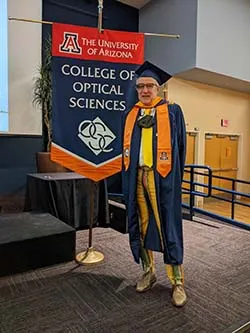
Where is your career headed now?
I just turned 63 but I don't see myself retiring anytime soon. My day job at Waymo continues. I lead a team of software engineers developing advanced lidars for autonomous vehicles. You can ride in our current generation of autonomous vehicles in Phoenix today. My participation in IEC TC76 on laser safety likewise continues. I'm looking forward to our next AGM in September 2022 in my hometown of Sydney. This will be our first in-person gathering since the disruption of COVID-19 and it will give me great pleasure to present the results on pupil size for retinal hazards produced in the preparation of my master's report.
Name three neat facts about you.
- I was on the 19th floor of a building in Tokyo at 14:46 JST on March 11, 2011, pitching a video processing chip to Sony. Paradoxically, experiencing a major earthquake made me more willing to move to the Bay Area when I joined Google a year and a half later.
- I delivered my second child on the shoulder of a freeway. I remembered well the words of the gynecologist at the birth of my first child: newborns are slippery, don't drop them. I didn't. The birth was without complications so we drove to the clinic where the birth was supposed to take place. We were met by a nurse in the parking lot holding out surgical scissors for me to use to cut the umbilical cord. My son has the distinction of taking his first breaths in Montigny-le-Bretonneux but being born in Boulogne-Billancourt, since French law defines the place of birth as where the cord is cut.
- My most treasured suit is a rather colorful limited edition Paul Smith that I first wore at my wedding reception in 1998 and have worn at various times in subsequent years. I wore it at the OSC 2022 commencement ceremony.
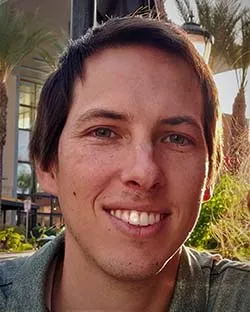
Weslin Pullen
Where are you from?
I am a native Tucsonan, born and raised!
Why did you choose to advance your education by earning an M.S. in optics?
I love learning, and I love optics(/physics)! So, deepening my understanding of optics while simultaneously enhancing/advancing my career made the choice too easy.
Describe how your wife and children (and how being a dad) had a role in helping you to thrive throughout graduate school?
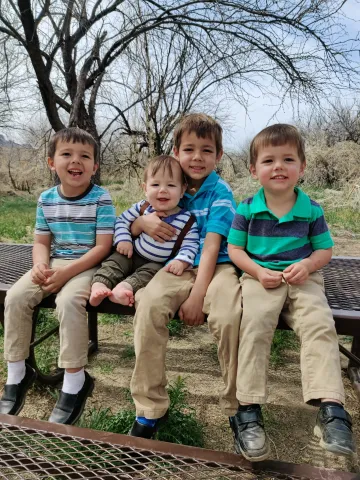
I don't know if "thrive" is the right word... pursuing an MS was a little bit difficult. With kids at home (started grad school with only one, ended with four!), we (Nicole and I) decided that she would work less and less, which meant I needed to work full-time to support our growing family. Working full-time in industry, while schooling about half-time, with a family that just wanted to play Legos or go on bike rides, meant I needed to organize my time. My schedule was as follows. Monday through Friday from morning until dinner I was at work. Evenings until the kid’s bedtime was pure family time. After the kids went to bed is when I took care of schoolwork. Saturdays were a mix depending on what was going on, and Sundays were entirely devoted to family time (no work or school!). It was definitely challenging at times, but by focusing on my family and with their support, I was able to stay focused and get through it!
Describe your research in 200 words or fewer.
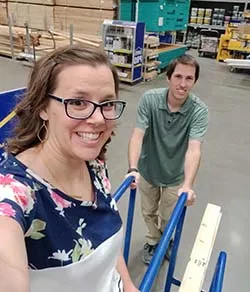
I honestly would not define my research by my thesis, which is what is intended by this question. Rather, my research is never-ending and ever-increasing. Throughout my time during graduate school, whether school-related or otherwise, I found myself studying various techniques to measure wavefronts and optical surface figure, and how to more efficiently fabricate optics, how to design/develop novel wavefront sensors for adaptive optics systems, designing optical systems and analysing performance by means of stray light and STOP analysis to name a few. You might be able to boil down my focus areas to: Optical design, analysis, fabrication and test.
Where is your career headed now?
My career is currently focused on optical design, analysis and testing, but I am moving more and more towards technical leadership, hoping to provide even more mentoring for junior engineers to learn how to perform these very important tasks.
Name three neat facts about you.
- I love music and have desires to learn a handful of instruments! But I also love the sounds of nature so you will almost never find me wearing headphones.
- My favorite time ever is 4:30-5:30 Tucson summer mornings; no one else is awake (i.e. minimal traffic sounds, etc.), the sun is still behind the mountains so while it's light out it is not yet blazing hot, birds are barely starting to wake up and sing their morning songs... But I also don't like sleep so I end up staying up too late and find myself unable to wake up so early... I'm getting better, I promise! And having a handful of kids that wake me up early also helps!
- I am the only son of an only son of an only son, for a few generations. And now I have only sons - four of them!
